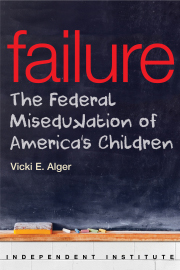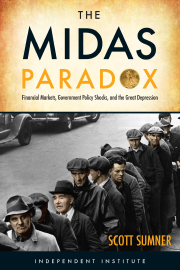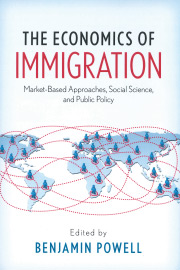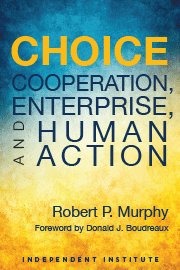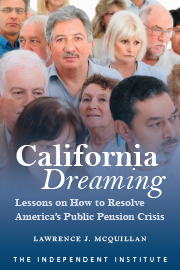K. Lloyd Billingsley • Monday, August 20, 2018 •
As we noted last October, the cost of Gov. Jerry Brown’s beloved delta water tunnel was estimated at $16 billion, more than 2.5 times larger than the expected benefits. This was according to Benefit-Cost Analysis of The California WaterFix, by Jeffrey Michael of the Center for Business and Policy Research at the University of the Pacific. The digging had yet to begin, but the project has already struck corruption.
According to the state auditor, the state Department of Water Resources “did not follow state law when it replaced the program manager for the conservation and conveyance program.” The DWR selected the Hallmark Group “without advertising a request for qualifications,” and “the cost of DWR’s current contract with Hallmark has tripled from $4.1 million to $13.8 million.” In addition, the DWR was handing out no-bid deals to contractors without vetting them.
Now comes word that the project has jumped to nearly $20 billion, a 22 percent increase from last year’s $16.3 billion. Backers attribute the jump to inflation, but taxpayers will recognize the familiar pattern. To make mammoth projects palatable, politicians pitch them at lower prices. Then, once they gain approval, they bring on the “cost overruns” and such. Consider the new span of the San Francisco Bay Bridge, $5 billion above budget, ten years late, and riddled with safety issues. By that standard, the WaterFix could cost a lot more than $20 billion, without ever fixing anything.
It would be hard to blame California taxpayers for seeing WaterFix as a legacy project for outgoing governor Jerry Brown. In similar style, costs of the governor’s vaunted bullet train are at least $77.3 billion and could rise to $98.1 billion. Back in 2008, the cost of the 800-mile rail project was $35 billion. No passenger has taken a ride, but the state’s high-speed rail authority has established a Sacramento headquarters and three regional offices.
***
K. Lloyd Billingsley is a Policy Fellow at the Independent Institute and a columnist at The Daily Caller.
Craig Eyermann • Monday, August 20, 2018 •
The Government Accountability Office recently reported on federal employee misconduct within the U.S. government. Eric Katz of GovExec covered the report’s surprising main finding:
One in four federal employees suspended by federal agencies in 2016 had been suspended before, according to a new review, which suggested an array of best practices for agencies to reduce misconduct in the workplace.
About 60 percent of serious disciplinary actions—including suspensions of more than 14 days, firings and demotions—in a given year are suspensions, the Government Accountability Office found in a new report. Overall, such actions are rare. Fewer than 1 percent of federal employees face such punishments on an annual basis.
Since the report focuses on employee misconduct, as opposed to poor performance, it is documenting only what happens to about 1% of the overall U.S. government civilian workforce in any given year. The following chart shows how the cases of federal bureaucrats charged with misconduct were dispositioned in the years from 2006 through 2016.
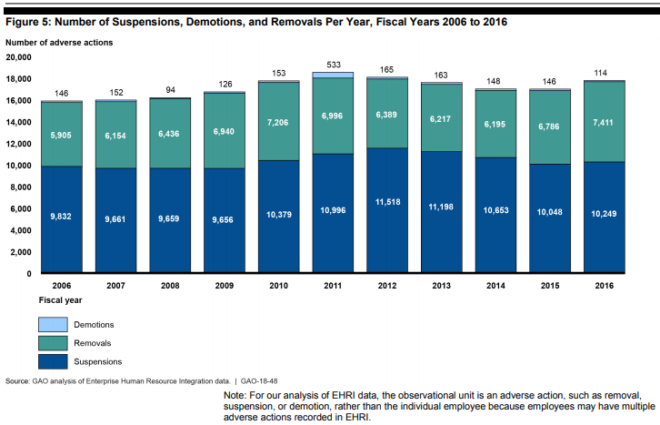
K. Lloyd Billingsley • Thursday, August 16, 2018 •
“We’re not going to make America great again,” Andrew Cuomo proclaimed, “It was never that great.” That is a rather sweeping statement but skeptics might find clarification in Cuomo’s 2014 book All Things Possible: Setbacks and Success in Politics and Life.
According to the author, twelve years of Ronald Reagan and George H.W. Bush brought on a “malaise.” So for Cuomo, the nation was clearly not great during that stretch. But then the election of Bill Clinton in 1992 renewed hope.
“Bill Clinton and Al Gore were the next generation,” Cuomo says. “They made government cool again.” And unlike Republicans, Clinton took on the country’s “large-scale urban ills.” When Clinton issued an executive order “directing HUD to break the cycle of homelessness in America,” he put Andrew Cuomo in charge of that task. As the new boss of Housing and Urban Development discovered, maybe government wasn’t so cool after all.
Cuomo quotes former HUD boss Henry Cisneros saying the massive federal agency is “a bureaucracy far more attentive to process than results, characterized by slavish loyalty to nonperforming programs.” And Cuomo learned the same lesson: “HUD had taught me that a central-government-knows-best approach rarely produces the best results.” In fact, adds Cuomo, “even the physical space at HUD was dysfunctional.” So this American government bureaucracy was not great, but what about government education?
Craig Eyermann • Thursday, August 16, 2018 •
Shortly after being sworn into office, President Donald Trump signed an executive order that directed federal government agencies to revoke two existing regulations for every new regulation they might issue.
That executive order represents the President acting to fulfill a campaign pledge he made to reduce the burden of federal regulations on Americans. The question of how well the President’s action to reduce federal regulations is working has just been in the news because of a rather astounding claim made by Vice President Mike Pence while speaking in St. Louis.
It’s no accident this President has been busy doing exactly what he told the American people he’d do leading up to that election in 2016. He promised to roll back the heavy hand of government. And working with your great leaders in Congress—remember when the President promised that we’d repeal two federal regulations for every new federal rule that we put on the books? Well, I’m here to report to you that we haven’t actually done that. This President has actually repealed 22 federal regulations for every new federal rule put on the books. He’s repealed more federal regulations than any President in American history.
Craig Eyermann • Tuesday, August 14, 2018 •
When the elected officials and bureaucrats who run a government want to stack the deck in favor of a politically connected special interest, they have three main ways that they can go about it:
- They can subsidize the special interest, often using taxpayer cash.
- They can penalize the competition of the special interest, often through tariffs.
- They can mandate that people do business with the special interest.
Each of these actions is economically harmful as government-backed subsidies, penalties and mandates all impose unnecessary costs on regular people. Worse, they often lead to predictable, if often unintended, consequences that do serious damage beyond what they do to personal finances.
In the case of ethanol in the United States, the federal government has employed all three measures over the years, frequently with bipartisan political support. Its subsidies keep afloat politically connected businesses that wouldn’t otherwise be able to keep themselves in business. Its tariffs have kept consumers from being able to buy cheaper sources of ethanol on the global market. And its mandate to put an increasing amount of corn-based ethanol into fuel makes food more expensive.
K. Lloyd Billingsley • Tuesday, August 14, 2018 •
Back in 2013, the House Oversight and Government Reform Committee looked into the case of John Beale of the U.S. Environmental Protection Agency. In his quest for the job, Beale said he worked for former Senator John Tunney of California. Beale also said he served in Vietnam, contracted malaria, and therefore need a handicapped parking spot. Neither claim was true, but Beale got both the job and the handicapped spot. The “policy advisor” told EPA bosses he also worked for the CIA, but nobody bothered to check. Beale maintained this ruse for nearly 20 years, performing little if any work, but the EPA duly paid him retention bonuses. The EPA continued to pay Beale his salary nearly two years after he retired. He had to pay back some $900,000 but still collects his generous federal retirement, so in a sense, he got away with it. That is a tough act to follow but a contender has recently come to light.
William Shughart • Monday, August 13, 2018 •
China is President Trump’s favorite whipping boy when it comes to blaming other nations for our chronic international trade deficits. Good economists – a category that assuredly does not include the president’s trade advisor Peter Navarro – don’t worry at all about the balance of trade with any single trading partner. We look for other logical reasons explaining why the United States buys more goods from one nation than we sell to it.
A case in point: the rare earth minerals purchased by the armed forces and critical to national defense. America’s supplies of those materials depend heavily on imports from China and other unfriendly countries.
As a matter of fact, the U.S. Department of Defense procures 750,000 tons of minerals and metals every year. Many of them are essential for manufacturing armaments ranging from bullets, turbine engines, advanced radar and electronic warfare systems, to missiles.
The United States imports half of 50 critical minerals and 100 percent of 21 of them. The imports are shipped from many countries in various corners of the globe – South America, Australia, Africa and Asia. But the largest share by far originates in China or from mines located elsewhere that are owned by Chinese companies.
K. Lloyd Billingsley • Friday, August 10, 2018 •
To back up a bit, it recently emerged that over a period of four years a DMV key data operator slept at her desk for extended periods instead of working. This unnamed DMV drone duly kept her job. While she and, according to insiders, many others doze away, Californians such as Tyré Nichols spend six hours in miserable 98-degree heat waiting for simple DMV service, and such lag times are typical.
Over the last year, DMV wait times have increased 60 percent, delaying Californians by up to seven hours. These delays prompted some legislators to demand an audit, but DMV boss Jean Shiomoto was opposed. “Any audit you have to pull a lot of documents,” she told reporters, “It would strain our resources.” Shiomoto announced no new policy of dismissing those employees who sleep on the job for extended periods over a span of four years. On the other hand, she did request an additional $26 million to hire 400 new employees.
The measure to audit the DMV failed when three Democrat senators declined to vote. Then after killing the audit, which would have shown how the DMV had been spending public funds, legislators handed the DMV another $16 million taxpayer dollars. So as any taxpayer can see, this outfit is incompetent, unaccountable, and probably unreformable as it sits. Trouble is, some legislators are representing the DMV to their constituents and not the other way around, and it gets worse.
Inside the Legislative Office Building on N Street in Sacramento, behind an unmarked door, is a secret DMV office for California lawmakers and legislative staffers. No long lines at that office, which is not open to the general public. Members of the public must wait in line at regular offices, where DMV drones doze at their desks and get to keep their job. And DMV bosses get whatever they want, with no audit and no accountability. Doesn’t get much worse than that.
***
K. Lloyd Billingsley is a Policy Fellow at the Independent Institute and a columnist at The Daily Caller.
K. Lloyd Billingsley • Wednesday, August 8, 2018 •
In the state capital of Sacramento, a man named Tyré Nichols went online, secured all his paperwork, and arrived promptly at the Department of Motor Vehicles expecting to be in and out in two hours. Despite his preparation and punctuality, Nichols wound up waiting six hours, “in miserable 98-degree heat.” As it happens, this is a typical experience. Over the past year, DMV wait times have increased 60 percent, delaying Californians by up to seven hours. While Californians wait in line, DMV employees sleep on the job.
As we noted, according to California’s state auditor, “A key data operator at the Department of Motor Vehicles failed to perform her essential duties over a period of nearly four years because she slept at her desk for extended periods of time during work hours. From February 2014 through December 2017, the employee misused more than 2,200 hours of work time as a result of sleeping on the job, costing the state more than $40,000.” The unnamed employee still works at the DMV, her job protected by the powerful Service Employees International Union, which parades outside the capitol chanting “This is our house!” Other DMV employees have been using Californians’ personal information to commit bank fraud and identity theft, and DMV bosses have taken bribes to alter records and hand out commercial driving licenses.
These lapses have prompted legislators to demand an audit, but DMV boss Jean Shiomoto is opposed. “Any audit you have to pull a lot of documents,” she told reporters. “It would strain our resources.” Shiomoto is requesting an additional $26 million to hire 400 new employees, but she announced no new policy of dismissing those employees who sleep on the job for extended periods over a span of four years. According to insiders, this sort of sloth is common. Until the DMV starts showing deadbeats the door, a ballpark figure for additional funds should be zero. Legislators should conduct the audit whether or not Shiomoto wants it, and if she resists they should show her the door without delay.
***
K. Lloyd Billingsley is a Policy Fellow at the Independent Institute and a columnist at The Daily Caller.
Raymond March • Tuesday, August 7, 2018 •
The Food and Drug Administration determines which drugs can be prescribed in the United States. However, the FDA does not tell physicians how to prescribe drugs. When physicians prescribe drugs for uses other than their FDA-approved use, they engage in off-label drug prescription.
Off-label drug prescription is extremely common. By some estimates, 25 percent of all prescriptions are for off-label uses. These rates can be exceptionally higher for conditions with few available treatments. Cancer, HIV/Aids, many mental illnesses, and large sections of pediatrics heavily depend on off-label drug prescriptions.
Although how to prescribe drugs is left to the physician, the FDA heavily regulates information distribution about off-label uses. Unfortunately for physicians and drug providers, restrictions on what information is allowed to be distributed, as well as how it is distributed, are mind-bogglingly complex.















